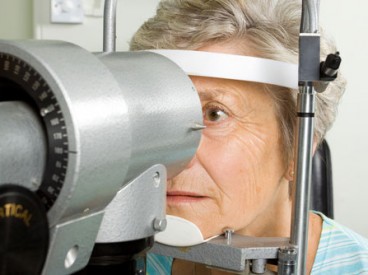Protecting Sight for Life

Nearly 15 million Americans over 40 have an eye disease that blurs objects directly in front of them—including faces, roadways, and printed words. Not so long ago, few treatments existed for the troublesome condition that doctors call age-related macular degeneration or AMD. Groundbreaking research, however, is giving way to new therapies (and new hope) for slowing the disease, restoring lost vision, and overcoming vision limitations.
The following information from the American Academy of Ophthalmology provides the latest clinical advances and vision-saving measures for both forms of AMD: wet (characterized by damage and swelling from leaky blood vessels in the back of the eye) and dry (damage not associated with swelling).
Dry AMD
The most exciting new approaches for dry AMD (the most common form) include:
- Experimental medicine-secreting implants that protect dying cells;
- New drugs under development that aim to prevent damage to the retina;
- Clinical trials of medicines intended to slow the progression of dry AM; and,
- Second Sight, a prosthesis system now in U.S. clinical testing. The Second Sight implant attaches to the outside surface of the eye and connects to an electrode placed in the retina. A camera mounted on a pair of glasses communicates with the implant. The device is already used in Europe.
Wet AMD
About 10 percent of Americans with AMD have the wet form—the kind responsible for the most severe vision loss. Fortunately, new and highly effective therapies for wet AMD can dramatically reduce damage and stabilize vision with injectable drugs including:
- Avastin® and Lucentis®, shown to reduce visual acuity loss in most patients and improve vision in some; and,
- Eyela®, which received FDA-approval in late 2011 for treating AMD with less frequent injections.
“As ophthalmologists, we know all too well the devastating impact AMD can have on people,” said David W. Parke II, MD, CEO of the American Academy of Ophthalmology. “Fortunately, the past few years have been marked by significant improvement in understanding the causes of the disease, which in turn has led to better treatment options. Ophthalmologists can now endeavor to more effectively treat multiple forms of AMD and thereby provide new hope to our patients.”
AMD and Nutrition
Nutrition might hold one key to slowing the progress of AMD. The landmark study called the Age-Related Eye Disease Study (AREDS) showed that people at high risk for developing wet AMD or late-stage dry AMD who take a dietary supplement with specific, high levels of vitamin C, vitamin E, and beta carotene along with zinc, can decrease by about 25 percent their risk of macular degeneration progressing to advanced stages. The daily supplements also reduced the risk of vision loss for those at risk by about 19 percent. Patients should talk with their ophthalmologist to learn if supplements are recommended for them. A second study, AREDS2, is now underway to evaluate whether adding the supplements lutein and zeaxanthin and the omega-3 fatty acids DHA and EPA to the AREDS formula can provide further protection against late-stage AMD. (Results of this study are expected in 2013.) Other studies have shown that eating dark leafy greens as well as yellow, orange and other brightly-colored vegetables and fruits rich in lutein and zeaxanthin may reduce risk for developing macular degeneration. Eating fish and seafood high in omega-3 fatty acids has also been linked to lower risk of AMD.
Hi Tech Devices and Low Vision Services
If vision loss does occur, a variety of adaptations and devices can enable continued ability to read, use a computer and perform almost all routine activities. Recent innovations in consumer electronics − including tablets, e-readers and smartphones − can supplement traditional low-vision aids. For many patients with moderate to severe visual impairment, low vision rehabilitation clinics can provide needed assistance in enhancing visual function.
Free Eye Exams
Ophthalmologists acknowledge that this is an exciting time for research and treatment options for AMD, however, they would like to remind people that the first line of defense to help prevent unnecessary vision loss from age-related eye diseases is an eye exam. EyeCare America, a public service program of the Foundation of the American Academy of Ophthalmology, provides eye exams at no out-of-pocket cost to people age 65 and older. Click here for more and to see if you qualify.